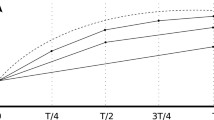Abstract
We propose the S-leaping algorithm for the acceleration of Gillespie’s stochastic simulation algorithm that combines the advantages of the two main accelerated methods; the \(\tau \)-leaping and R-leaping algorithms. These algorithms are known to be efficient under different conditions; the \(\tau \)-leaping is efficient for non-stiff systems or systems with partial equilibrium, while the R-leaping performs better in stiff system thanks to an efficient sampling procedure. However, even a small change in a system’s set up can critically affect the nature of the simulated system and thus reduce the efficiency of an accelerated algorithm. The proposed algorithm combines the efficient time step selection from the \(\tau \)-leaping with the effective sampling procedure from the R-leaping algorithm. The S-leaping is shown to maintain its efficiency under different conditions and in the case of large and stiff systems or systems with fast dynamics, the S-leaping outperforms both methods. We demonstrate the performance and the accuracy of the S-leaping in comparison with the \(\tau \)-leaping and R-leaping on a number of benchmark systems involving biological reaction networks.






Similar content being viewed by others
References
Anderson DF, Kurtz TG (2011) Continuous time Markov chain models for chemical reaction networks. Springer, New York, pp 3–42
Auger A, Chatelain P, Koumoutsakos P (2006) \(R\)-leaping: accelerating the stochastic simulation algorithm by reaction leaps. J Chem Phys 125(8):084103
Bayati B, Chatelain P, Koumoutsakos P (2011) Adaptive mesh refinement for stochastic reaction–diffusion processes. J Comput Phys 230(1):13–26
Bayati B, Owhadi H, Koumoutsakos P (2010) A cutoff phenomenon in accelerated stochastic simulations of chemical kinetics via flow averaging (FLAVOR-SSA). J Chem Phys 133(24):1–7
Cao Y, Gillespie D, Petzold L (2005) Multiscale stochastic simulation algorithm with stochastic partial equilibrium assumption for chemically reacting systems. J Comput Phys 206(2):395–411
Cao Y, Gillespie D, Petzold L (2006) Efficient step size selection for the tau-leaping simulation method. J Chem Phys 124(4):044109
Cao Y, Gillespie DT, Petzold LR (2005) Avoiding negative populations in explicit poisson tau-leaping. J Chem Phys 123(5):054104
Cao Y, Petzold LR (2006) Accuracy limitations and the measurement of errors in the stochastic simulation of chemically reacting systems. J Comput Phys 212(1):6–24
Cao Y, Gillespie DT, Petzold LR (2007) Adaptive explicit–implicit tau-leaping method with automatic tau selection. J Chem Phys 126(22):224101
Chattopadhyay I, Kuchina A, Süel GM, Lipson H (2013) Inverse gillespie for inferring stochastic reaction mechanisms from intermittent samples. Proc Natl Acad Sci 110(32):12990–12995
Erban R, Chapman J, Maini P (2007) A practical guide to stochastic simulations of reaction-diffusion processes. arXiv:0704.1908
Erban R, Chapman SJ (2009) Stochastic modelling of reaction–diffusion processes: algorithms for bimolecular reactions. Phys Biology 6(4):046001
Gillespie DT (1976) A general method for numerically simulating the stochastic time evolution of coupled chemical reactions. J Comput Phys 22(4):403–434
Gillespie DT (1977) Exact stochastic simulation of coupled chemical reactions. J Phys Chem 81(25):2340–2361
Gillespie DT (2001) Approximate accelerated stochastic simulation of chemically reacting systems. J Chem Phys 115:1716
Gillespie DT, Petzold LR (2003) Improved leap-size selection for accelerated stochastic simulation. J Chem Phys 119:8229
Kierzek AM (2002) STOCKS: STOChastic Kinetic Simulations of biochemical systems with Gillespie algorithm. Bioinformatics (Oxford, England) 18(3):470–481
Koumoutsakos P, Feigelman J (2013) Multiscale stochastic simulations of chemical reactions with regulated scale separation. J Comput Phys 244:290–297
Lipkova J, Zygalakis KC, Chapman SJ, Erban R (2011) Analysis of Brownian dynamics simulations of reversible bimolecular reactions. SIAM J Appl Math 71(3):714–730
Maamar H, Raj A, Dubnau D (2007) Noise in gene expression determines cell fate in Bacillus subtilis. Science 317(5837):526–529
Mjolsness E, Orendorff D, Chatelain P, Koumoutsakos P (2009) An exact accelerated stochastic simulation algorithm. J Chem Phys 130:144110
Rathinam M, Petzold LR, Cao Y, Gillespie DT (2003) Stiffness in stochastic chemically reacting systems: the implicit tau-leaping method. J Chem Phys 119:12784
Sandmann W (2009) Exposition and streamlined formulation of adaptive explicitimplicit tau-leaping. Technical report, Citeseer
Süel GM, Garcia-Ojalvo J, Liberman LM, Elowitz MB (2006) An excitable gene regulatory circuit induces transient cellular differentiation. Nature 440(7083):545–550
Tian T, Burrage K (2004) Binomial leap methods for simulating stochastic chemical kinetics. J Chem Phys 121:10356
Acknowledgements
PK and GA gratefully acknowledge support from the European Research Council (ERC) Advanced Investigator Award (No. 341117). The authors thank both anonymous reviewers for their insightful comments that have helped us to improve the content of the paper.
Author information
Authors and Affiliations
Corresponding author
Rights and permissions
About this article
Cite this article
Lipková, J., Arampatzis, G., Chatelain, P. et al. S-Leaping: An Adaptive, Accelerated Stochastic Simulation Algorithm, Bridging \(\tau \)-Leaping and R-Leaping. Bull Math Biol 81, 3074–3096 (2019). https://doi.org/10.1007/s11538-018-0464-9
Received:
Accepted:
Published:
Issue Date:
DOI: https://doi.org/10.1007/s11538-018-0464-9




